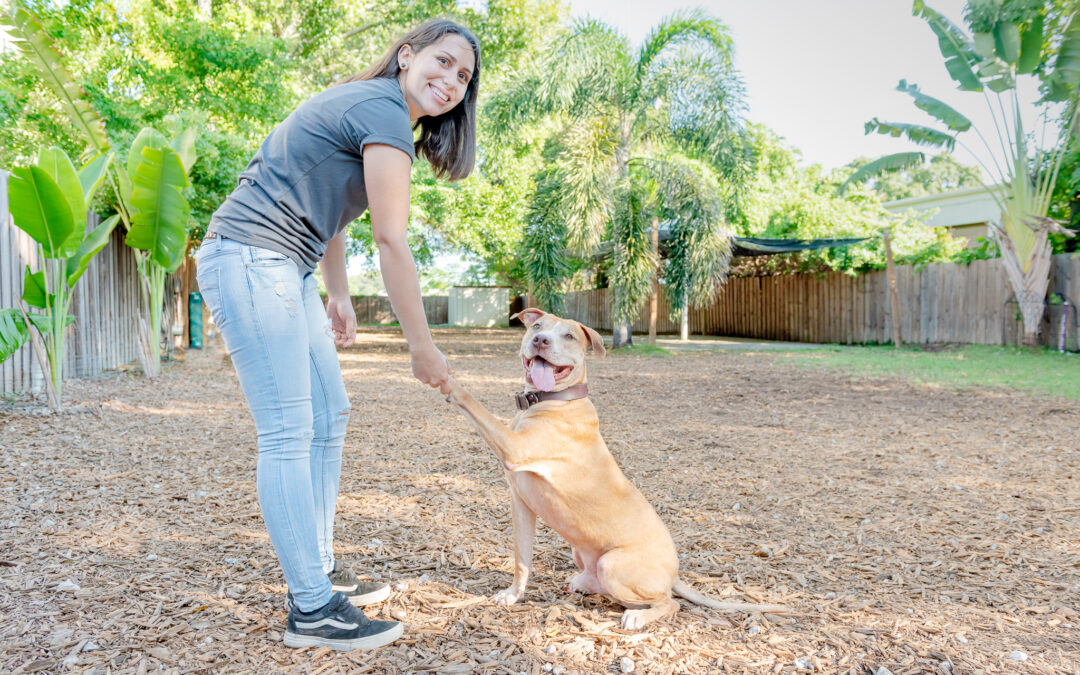Before I had kids, I would randomly get clients who needed their dog trained because a baby was coming. I was naïve to think that I could handle such a responsibility. Fortunately, no baby got hurt because of my ignorance. I walked into each situation like it was another obedience case and figured that if the dog had obedience training, the dynamic with the child would naturally fall into place. I rarely considered the dog’s age, breed of dog, history of the dog, how the owner managed their household, or if there were multiple dogs in the house. I had the best intentions and had no clue what the repercussions could have been. If most trainers are honest with themselves, this is the foundation of how we evolve into the trainers we are today. There’s that age-old saying, “I’m doing the best I can with the little I know until I can learn a little more and do better.”
I want to share my experiences and knowledge with my fellow trainers to educate new parents together. Doing this can help reduce the number of baby/toddler dog bites.
Here are some things I wish I had known before my years of studying and being submerged in this field.
- Consider the dog’s age, breed, history, and temperament. Educating the client on their dog’s breed age needs and characteristics can help them understand the common traits associated with this information. For example, if a senior dog has health issues, that dog most likely will have a lower threshold for a baby crawling on top of it. If they have a wolf hybrid, don’t be afraid to tell them they have no business letting a baby and that dog coexist. There is too much of a risk.
- Explain the different dog bite styles each dog possesses genetically. Herding breeds could nip a running child, whereas a terrier breed is predisposed to have a full-mouth grip while shaking their prey.
- It is also essential to talk to the client if there are multiple dogs in the house and they have a clear understanding of the pack mentality.
- The second observation is, how does this client run their household? Is it a “free zone”? Are they structured and controlled? Having this information will help you guide them during the evolving months after the baby is home with the dog.
- Having solutions such as incorporating a crate if the house is wide-open or having room for the dog during downtimes. Maybe a baby gate is the best option. Start implementing these changes around the house with your client before the baby arrives. Teaching them how to manage their environment practically will help get them to change some of their habits and routines with the dog.
- Before the baby arrives, it is time to foresee if the situation will be a success for the dog. If the client has a highly nervous dog with a low threshold and the people seem very relaxed with a free zone house, that is the time to tell them they could be setting their dog up to fail. Another example is if an excitable dog jumps all over people and furniture, that dog will need lots of impulse control around young kids.
Start treating the situation as if the baby is already in the picture. Do this by roleplaying and making the client realize that if their dog jumps on a sleeping baby, they could injure such a fragile newborn.
- During the first lesson with your expectant parents, bring a soundtrack of different newborn cries. Observing the dog’s reaction to the noise can give us instant information about the predatory drive level in the dog.
- Make sure to ask questions like, Does the dog chase small animals? Has the dog ever killed another animal? Does the dog get extremely aroused if kids are screaming, running, or playing? Has the dog ever jumped up at you or somebody else trying to nip at you or your clothes? If the answer is yes to any of these, you need to evaluate more in-depth to ensure this dog is safe bringing home a new baby.
- Remember, a dog might not perceive the newborn as a human in the first three months. Statistically, there are numerous accounts of a dog killing a newborn that was in a bassinet or a swing in the first 90 days. They are prey to them, and predatory drives are instinctual, with minimal signs before the attack.
- It is critical to pinpoint the red flags before the baby arrives so the client understands how to manage their dog and household accordingly. Don’t be afraid to tell a client if the dog is too dangerous to be around a baby. Then, they can find a home better suited for the dog or prepare themselves to set up a management plan with the dog while the baby is young. Clients don’t like to hear this, but you owe it to them if it is true. Never tell them this information over the phone. I made this mistake once when the client gave me substantial red flag predatory examples and suggested they consider rehoming. A year later, she texted me that her dog and the baby were best friends and that I should be ashamed of myself, almost making her give the dog away. I want to think because of my caution; she was extra diligent during the newborn stages of having her baby and dog together. I still have significant concerns over the situation. I should have met the dog and the totality of the picture before giving such strong advice.
- A bite does not need to happen to validate that the dog should have never been around a kid in the first place. When all the signs are there, don’t leave it to chance because it is not if it will happen; it is when it will happen.
- Test the dog around its bedding, a toy, a high-drive bone, and a bowl of food for their resource guarding levels. If a dog shows signs to an adult, they will do the same with a young child. Resource guarding is one of the significant causes of aggression towards small children. Toddlers carry around toys and food regularly. They don’t understand how to respect a dog’s space or possessions. The majority of these types of bites happen to the baby’s face or upper body, causing severe damage.
- Ask if the dog resource guards with other dogs because that could help you determine the level of the guarding.
- All dogs have some degree of this, but the severity of the dog’s default behavior could result in a baby getting injured. Some dogs will move away during the test. In contrast, others could show behaviors such as lifting their lip, growling, freezing, or biting when you approach or reach towards the dog.
- The purpose of this is not to correct the dog but rather to evaluate the core of the dog and what could potentially be situations that could arise once a baby is in the picture.
- No pet client wants to believe their dog can bite a child, but they need to see this in testing to understand. I used a fake arm or a real-life robotic crawling baby during my assessments on the first evaluation in the client’s home.
Dogs biting babies and toddlers is a bigger problem than most realize. Bite statistics are off the charts, and I get notified of every dog bite/killing that shows up in the news. I average about 2-3 a week. Most of these incidents are from the family dog or a friend’s dog. Babies under two who can’t understand dog language are mostly the victims. You might read this and feel bad, but I want this to ignite an emotional response. You won’t feel nearly as bad reading those statistics as you will when you have to see the wounds on an innocent child or witness the trauma that these children go through when a dog attacks them. A trainer who hasn’t seen what a dog is capable of doing won’t indeed be able to grasp the level of terror that runs through a family after a tragic event like this. Exposing yourself to these reports would be best before taking on another prospective client. For information about introducing a dog to a baby or skills to teach your client’s dog before a baby arrives, follow the Dogs to Diapers YouTube Page.



